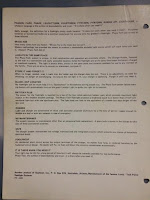This post is continued from my
Early Rechargeable Flashlight History Post.
Enter Streamlight. Originally incorporated as Streamlite in New Jersey, Streamlight started out producing industrial lighting. One of their first products was a handheld light for NASA. They later produced handheld spotlights for search and rescue and law enforcement. They didn't have a traditional flashlight early on but they weren't far away from producing one.
In 1978 Streamlight was located in Norristown, PA and started negotiations with Norm Nelson to purchase Kel-Lite and produce a rechargeable flashlight designed from the ground up, the SL-20.
Patent # 4171534. Rather than using the end cap the charging point was placed at the switch which simplified the overall design. During this time almost all aluminum flashlights were marketed towards police officers, firefighters and other professional trades. Not until Maglite came about were these lights seriously marketed towards general consumers. As such, the SL-20, showcasing the groundbreaking rechargeable technology, put all flashlight manufacturers at the time, with the exception of Maglite and Kel-Lite, out of business.
I was lucky enough to purchased a small police surplus lot of SL-20s. The SL-20s I have are from a later batch that was produced after Streamlight bought out Kel-Lite in 1983. Streamlight models after 1983 have the end caps stamped Norristown, PA / Barstow, CA because production was handled out of the Streamlight facility as well as the old Kel-Lite facility. Lights produced prior to 1983 were stamped only Norristown, PA and had a different serial numbering scheme.
This was the close of one chapter but the beginning of another. Kel-Lite was reduced to the non-rechargeable incandescent line produced by Streamlight but the rechargeable flashlight industry started to rule law enforcement sales. I've covered these 3rd gen Kel-Lite Streamlights,
here.
The serial numbering scheme was originally sequential with no letter prefixes. However after Streamlight bought Kel-Lite they needed to differentiate the alkaline and rechargeable lines so they added two letters to the prefix of the serial. These started with K for alkaline Kel-Lites and S for rechargeable SL-20s. They start at SA000001 and go up to SC999999. I don't have any beyond SC but SD and SE would be next.
The switch is an amazingly simple and reliable design. It has the fewest parts of any switch I've seen and hold up very well to serious abuse. The switch can be depressed for signalling or momentary on when it is in the off position or it can be slid forward to have the light constantly on. The break between the positive and negative contact points also serves as the charging points.
Unfortunately chargers can no longer be sourced. These lights are very rarely if ever found with chargers because the chargers were plastic and dry rotted and broke over the years. What is nice is they are exactly the same dimensions of a 3 D cell light. The lights were originally 5 cell NiCads so a rechargeable battery out of a Mag Charger or any of 3D sized light would work. I prefer to run them instead with a reduced voltage and 3 D cells. The lights will operate just fine but their brightness is significantly reduced as shown below.
The bulb is joined with the reflector which would make replacement of just the bulb very difficult. Luckily the halogen bulbs have a very long service light, so especially if they are operated on 3D cells the life should be even longer. They are connected to the switch terminals via jumper cables.
Streamlight also produced a plastic SL-15 model and an aluminum 5D cell sized SL-35. The 3D sized SL-20 was the most popular of the bunch. The SL-20 soldiered on for around 10 years. In the mid to late 1980s the SL-20X was introduced as a new and improved model. Original SL-20s are easily identifiable because they are stamped SL-20 behind the switch. Streamlight later introduced a plastic version, and still produces and SL-20L and SL-20LP which are direct descendants of the original SL-20s as shown below from Streamlight's website. The Streamlight Stinger is by far the more popular choice for officers though.

These lights are difficult to find but not well sought after by collectors like Kel-Lites and Maglites are. This is likely due to the fact that most are no longer operable due to lack of parts. Even with alkaline batteries their use is limited as they don't put out more than 40 lumens or so. They are a huge part of flashlight history though and I think they're pretty neat collectibles. Even to this day Streamlight Stingers, as well as Surefires, are hands down the most popular choices among law enforcement. Most people consider Maglites to be cop lights but aside from early Kel-Lites the Streamlight SL-20 is the light law enforcement favored the most. In good used condition they are worth around $20 today.
In 1982 the Mag Charger debuted and I've picked up the history of rechargeables with a post about it on my Maglite blog that can be found
here. The Mag Charger didn't give the SL-20 a big run for it's money but it was still an important light.
As always I'm looking to buy vintage and rare aluminum flashlights. Please let me know if you have any, top dollar paid.







































